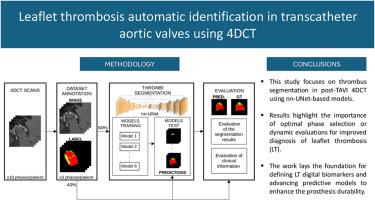Leaflet thrombosis automatic identification in transcatheter aortic valves using 4DCT
IF 6.3
2区 医学
Q1 BIOLOGY
引用次数: 0
Abstract
Leaflet thrombosis (LT) is a significant complication of transcatheter aortic valve implantation (TAVI) that impacts patient outcomes and transcatheter heart valves (THVs) long-term durability. Subclinical LT (SLT), manifested as hypo-attenuated leaflet thickening (HALT) and potential reduced leaflet motion (RELM), is challenging to diagnose due to its reliance on manual evaluation and observer variability. Although computed tomography (CT) is the preferred imaging modality for LT detection, manual assessment remains labor-intensive and prone to inconsistencies. Additionally, as TAVI procedures are increasingly performed in younger patients, concerns about THVs long-term durability —and particularly regarding LT— are growing. This study aims to develop automated segmentation models using the nnU-Net architecture to detect and characterize thrombi in 4DCT scans of TAVI patients. The methodology includes three main steps: manual annotation of the dataset, thrombus segmentation using eight distinct nnU-Net models, and evaluation based on segmentation metrics and clinical thrombus information. Several models achieved precision values exceeding 0.8 for LT patients, demonstrating the potential of automated segmentation to enhance LT detection. Furthermore, the observed variations in thrombus volume across the cardiac cycle highlight the importance of selecting the optimal phase for LT assessment, suggesting that dynamic evaluation could improve diagnostic accuracy. This work lays the groundwork for early LT detection and the development of predictive biomarkers, offering automated LT detection and characterization that reduces manual effort and observer variability. The proposed dynamic 4DCT analyses could improve LT diagnostics and inform personalized anticoagulation strategies, potentially leading to better long-term outcomes.

经导管主动脉瓣小叶血栓形成的4DCT自动识别
小叶血栓形成(LT)是经导管主动脉瓣植入术(TAVI)的重要并发症,影响患者预后和经导管心脏瓣膜(thv)的长期使用寿命。亚临床LT (SLT)表现为小叶减薄增厚(HALT)和潜在的小叶运动减少(RELM),由于其依赖于人工评估和观察者变异性,诊断具有挑战性。尽管计算机断层扫描(CT)是LT检测的首选成像方式,但人工评估仍然是劳动密集型的,而且容易出现不一致。此外,随着TAVI手术越来越多地在年轻患者中进行,对thv长期耐久性的担忧——特别是对LT的担忧——正在增加。本研究旨在开发使用nnU-Net架构的自动分割模型,以检测和表征TAVI患者的4DCT扫描中的血栓。该方法包括三个主要步骤:数据集的手动注释,使用八种不同的nnU-Net模型进行血栓分割,以及基于分割指标和临床血栓信息的评估。有几个模型在LT患者中达到了超过0.8的精度值,这表明了自动分割在增强LT检测方面的潜力。此外,观察到的血栓体积在整个心脏周期内的变化突出了选择LT评估的最佳阶段的重要性,这表明动态评估可以提高诊断的准确性。这项工作为早期LT检测和预测性生物标志物的开发奠定了基础,提供了自动化LT检测和表征,减少了人工工作量和观察者的可变性。提议的动态4DCT分析可以改善LT诊断并为个性化抗凝策略提供信息,可能导致更好的长期结果。
本文章由计算机程序翻译,如有差异,请以英文原文为准。
求助全文
约1分钟内获得全文
求助全文
来源期刊

Computers in biology and medicine
工程技术-工程:生物医学
CiteScore
11.70
自引率
10.40%
发文量
1086
审稿时长
74 days
期刊介绍:
Computers in Biology and Medicine is an international forum for sharing groundbreaking advancements in the use of computers in bioscience and medicine. This journal serves as a medium for communicating essential research, instruction, ideas, and information regarding the rapidly evolving field of computer applications in these domains. By encouraging the exchange of knowledge, we aim to facilitate progress and innovation in the utilization of computers in biology and medicine.
 求助内容:
求助内容: 应助结果提醒方式:
应助结果提醒方式:


